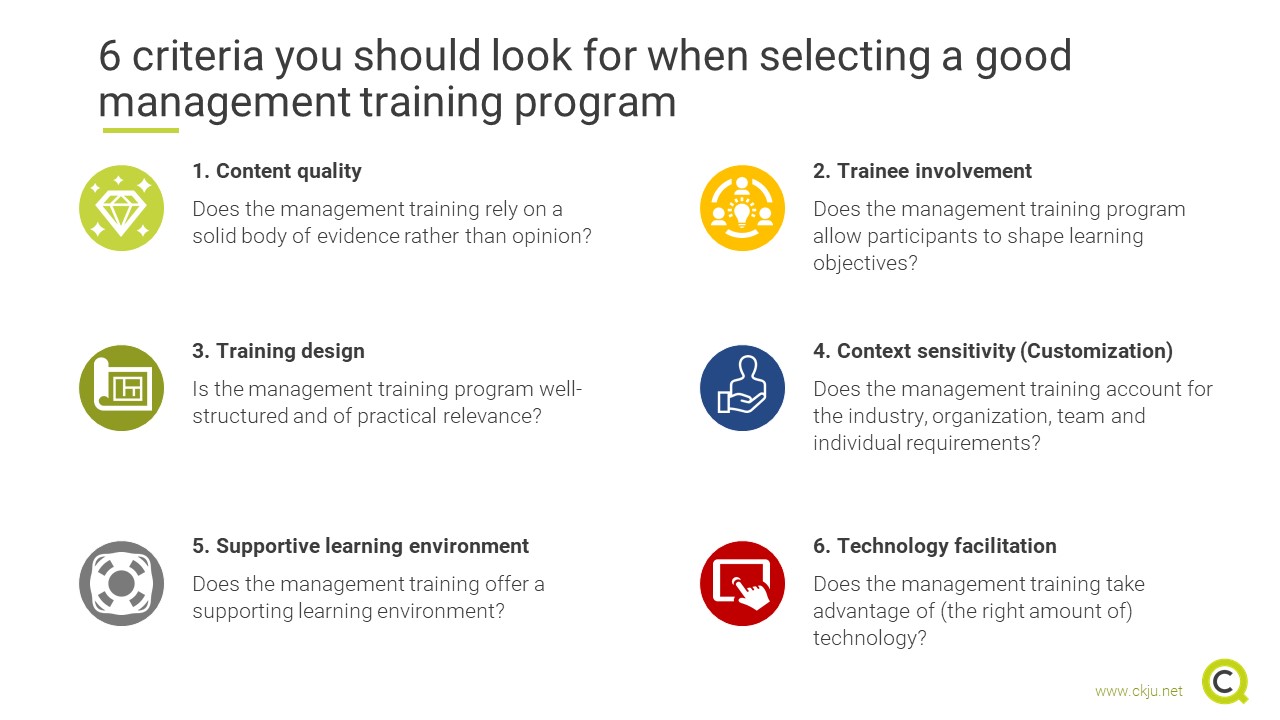- Blog
- 6 criteria you should look for when selecting a good management training program
Contents
- Does the management training rely on a solid body of evidence rather than opinion?
- Does the management training program allow participants to shape learning objectives?
- Is the management training program well-structured and of practical relevance?
- Does the management training account for the industry, organization, team and individual requirements?
- Does the management training offer a supporting learning environment?
- Does the management training take advantage of (the right amount of) technology?
- References and further reading
Does the management training rely on a solid body of evidence rather than opinion?
Content quality is one of the most important criteria of a good management training program. However, as all trainers will tell you that their management training is best, you should be able to evaluate the training's quality at least to a certain extend by yourself. And yes, there are some guidelines available you can easily follow to get a good understanding whether the training is worth it. Those guidelines are rooted in evidence-based management which targets at improving the decision making quality in management.
In evidence-based management it is all about whether the claims made are supported by empirical evidence rather than individual opinion. Why? Because this is the only way to make sure that the management skills you will learn in the training do really have a positive impact on real-life outcomes. You can do a first quality check by asking the following questions:
- Does the training encourage critical thinking?
- Does the training incorporate knowledge from empirical studies?
- Does the training avoid overly simplistic claims?
When your answers to these questions are "No" the management training is most properly of poor quality and will be a waste of time. When your answers are "Yes" the training seems to be worth it. You want to learn more about how to evaluate knowledge quality in management? Then you should have a look at the benefits of evidence-based management in a nutshell.
Does the management training program allow participants to shape learning objectives?
Too often, classical hierarchic structures prevail in management training. Experts, consultants or trainers present their specific knowledge which is in turn internalized by the employees – not very encouraging or motivating. However, self-motivation plays a key role in learning transfer. Recent findings in the field of motivational research confirm that the sense of active participation is an important prerequisite for high self-motivation (Gagné and Deci, 2005). As soon as the trainee gets the impression that he is able to actively shape specific learning objectives as well as the learning process as a whole, self-motivation is increased immensely. Solely interactive learning is able to achieve optimal results for both sides.
Naturally, not every single detail needs to be discussed and agreed upon with the respective training participants. Nevertheless, every participant should be able to identify with his/her learning target as well as their implementation. This is an interactive communication process that ensures that trainees feel represented with the training goals and their implementation. In addition, it also boosts self-efficacy which is an important driver of learning transfer. At the same time, the trainer gets the chance to understand the context of his target group and to customize the training to its audience.
Management skills newsletter
Join our monthly newsletter to receive management tips, tricks and insights directly into your inbox!
Is the management training program well-structured and of practical relevance?
Management training does not only take money and time, but also occupies a considerable level of cognitive resources from its participants (Jong, 2010). During the training, participants evaluate the training content regarding its relevance and connect it to their existing knowledge and mental models. Poorly structured management trainings, too much content and a lack of practical relevance put an additional strain on trainees' cognitive resources which makes learning harder.
Effective training design reduces the evaluation and categorization effort for the participants by building on pre-existing sector knowledge and expertise (Kalyuga, 2009). Aspects such as the choice of words and cultural compatibility play an important role as well (see next criteria). This all translates into the criteria that management training programs should be well-structured and of practical relevance such that the training participants get most out of it.
Does the management training account for the industry, organization, team and individual requirements?
Every industry, organization, team and individual has its specific characteristics. For instance, things that are of utmost importance for one organization could be of no importance at all for another one. The most comprehensive and well-structured training content is useless if it is just implemented according to the book meaning that it is not adapted to those characteristics. in a worst case scenario, the trainees reject the training or just find it not usefull when it doesn't reflect their "home turf". This makes it hard to use a standardized course structure as most traditional MBA classes do.
It is of great importance to spend time to get to know the industry, organization and training participants in order to make the management training as context specific as possible. For example, software company employees work differently than mechanical engineers. Even the language used varies in different industries. A good management training takes this into consideration as does the trainer.
Does the management training offer a supporting learning environment?
Learning increases risk appetite since well-known territories are left behind in favor of discovering new contents. An impression of safety and the feeling that the risks connected with doing something new are limited is indispensable for the learning process. “Psychological safety” (Edmondson and Lei, 2014) describes a setting where open and trustful communication (speak-up culture) is supported.
When a trainer is able to create a psychological safe environment, power gaps between the participants and trainer fade into the background and focusing on a common goal to improve and develop becomes more dominant. Conflicts are addressed openly and are solved on a professional as well an emotional level where the participants do not have to worry about risking to being at a disadvantage. A set of workshop or training rules and a trainer that emphasizes his/her role as a neutral facilitator rather than the subject matter expert are specific measures to foster a safe environment.
Supervisor support has also a positive impact on the transfer of learning. Thus, a good management training program does not just offer a supporting learning enviroment but also involves the trainees' supervisors in an organizational setting.
Does the management training take advantage of (the right amount of) technology?
Since the digital revolution, e-learning is the new standard rather than an exeption. However, there are still many management trainings around that solely rely on the traditional instructor-led classroom training approach. A good management training program takes advantage of technology where it makes sense but does not use technology just for the sake of it.
- First of all, e-learning can make a management training much more cost effective as people from around the globe can participate online without having to travel. A nice side effect of this location independence is that it also allows people from diverse backgrounds participate in one and the same training.
- Second, technology facilitated learning opens up new oppourtinities of asynchronous learning which makes the learning experience even more flexible. In addition, it allows the training participants to manage the pace of learning by themselfs.
- Third, e-learning allows the trainer to utilize different types of multimedia content such as presentations, videos, pictures and documents. Furthermore, digital content is much easier to share and update which makes it easier to customize training material and less costly to share it.
As with all management interventions, there is no one size fits all approach in using technology in management trainings. You will find a good management training taking advantage of above mentioned features while simultaneously keeping negative side effects at bay.
Not all management trainings are made equal. As most companies and trainers will tell you that their management training is best, it is up to you to separate the wheat from the chaff. The criteria we presented in this article are a good starting point to do so.
References and further reading
Edmondson, A. C. and Lei, Z. (2014) ‘Psychological Safety: The History, Renaissance, and Future of an Interpersonal Construct’, Annual Review of Organizational Psychology and Organizational Behavior, vol. 1, no. 1, pp. 23–43.
Gagné, M. and Deci, E. L. (2005) ‘Self-determination theory and work motivation’, Journal of Organizational Behavior, vol. 26, no. 4, pp. 331–362.
Griffin, R. (2011) ‘Seeing the wood for the trees: Workplace learning evaluation’, Journal of European Industrial Training, vol. 35, no. 8, pp. 841–850.
Grossman, R. and Salas, E. (2011) ‘The transfer of training: What really matters’, International Journal of Training and Development, vol. 15, no. 2, pp. 103–120.
Jong, T. de (2010) ‘Cognitive load theory, educational research, and instructional design: Some food for thought’, Instructional Science, vol. 38, no. 2, pp. 105–134.
Kalyuga, S. (2009) ‘Knowledge elaboration: A cognitive load perspective’, Learning and Instruction, vol. 19, no. 5, pp. 402–410.
Noe, R. A., Tews, M. J. and McConnell Dachner, A. (2010) ‘Learner Engagement: A New Perspective for Enhancing Our Understanding of Learner Motivation and Workplace Learning’, The Academy of Management Annals, vol. 4, no. 1, pp. 279–315.
Top Rated
About the Author

Comments
Most Read Articles
Blog Categories
RELATED SERVICES










Add comment